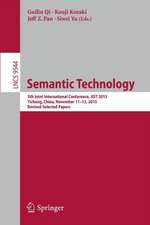Laboratory Experiments in Information Retrieval: Sample Sizes, Effect Sizes, and Statistical Power: The Information Retrieval Series, cartea 40
Autor Tetsuya Sakaien Limba Engleză Hardback – 4 oct 2018
Chapters 6 and 7 discuss statistical power. Chapter 6 introduces topic set size design to enable test collection builders to determine an appropriate number of topics to create. Readers can easily use the author’s Excel tools for topic set size design based on the paired and two-sample t-tests, one-way ANOVA, and confidence intervals. Chapter 7 describes power-analysis-based methods for determining an appropriate sample size for a new experiment based on a similar experiment done in the past, detailing how to utilize the author’s R tools for power analysis and how to interpret the results. Case studies from IR for both Excel-based topic set size design and R-basedpower analysis are also provided.
| Toate formatele și edițiile | Preț | Express |
|---|---|---|
| Paperback (1) | 325.80 lei 6-8 săpt. | |
| Springer Nature Singapore – 29 dec 2018 | 325.80 lei 6-8 săpt. | |
| Hardback (1) | 331.91 lei 6-8 săpt. | |
| Springer Nature Singapore – 4 oct 2018 | 331.91 lei 6-8 săpt. |
Din seria The Information Retrieval Series
- 20%
 Preț: 1908.14 lei
Preț: 1908.14 lei - 20%
 Preț: 651.89 lei
Preț: 651.89 lei - 20%
 Preț: 988.32 lei
Preț: 988.32 lei - 20%
 Preț: 646.80 lei
Preț: 646.80 lei - 20%
 Preț: 2189.11 lei
Preț: 2189.11 lei - 20%
 Preț: 652.22 lei
Preț: 652.22 lei - 15%
 Preț: 642.18 lei
Preț: 642.18 lei - 20%
 Preț: 1900.73 lei
Preț: 1900.73 lei - 20%
 Preț: 652.41 lei
Preț: 652.41 lei - 20%
 Preț: 647.79 lei
Preț: 647.79 lei - 20%
 Preț: 944.77 lei
Preț: 944.77 lei - 20%
 Preț: 652.07 lei
Preț: 652.07 lei - 20%
 Preț: 1444.03 lei
Preț: 1444.03 lei - 20%
 Preț: 990.12 lei
Preț: 990.12 lei - 15%
 Preț: 644.82 lei
Preț: 644.82 lei - 20%
 Preț: 646.95 lei
Preț: 646.95 lei - 20%
 Preț: 653.56 lei
Preț: 653.56 lei - 20%
 Preț: 768.06 lei
Preț: 768.06 lei - 20%
 Preț: 648.59 lei
Preț: 648.59 lei - 20%
 Preț: 648.59 lei
Preț: 648.59 lei - 20%
 Preț: 326.64 lei
Preț: 326.64 lei - 20%
 Preț: 776.69 lei
Preț: 776.69 lei - 20%
 Preț: 1276.08 lei
Preț: 1276.08 lei - 20%
 Preț: 697.27 lei
Preț: 697.27 lei - 20%
 Preț: 335.52 lei
Preț: 335.52 lei - 20%
 Preț: 658.98 lei
Preț: 658.98 lei - 20%
 Preț: 646.12 lei
Preț: 646.12 lei
Preț: 331.91 lei
Preț vechi: 414.89 lei
-20% Nou
Puncte Express: 498
Preț estimativ în valută:
63.52€ • 65.91$ • 53.09£
63.52€ • 65.91$ • 53.09£
Carte tipărită la comandă
Livrare economică 15-29 martie
Preluare comenzi: 021 569.72.76
Specificații
ISBN-13: 9789811311987
ISBN-10: 9811311986
Pagini: 148
Ilustrații: IX, 150 p. 53 illus., 43 illus. in color.
Dimensiuni: 155 x 235 x 17 mm
Greutate: 0.4 kg
Ediția:1st ed. 2018
Editura: Springer Nature Singapore
Colecția Springer
Seria The Information Retrieval Series
Locul publicării:Singapore, Singapore
ISBN-10: 9811311986
Pagini: 148
Ilustrații: IX, 150 p. 53 illus., 43 illus. in color.
Dimensiuni: 155 x 235 x 17 mm
Greutate: 0.4 kg
Ediția:1st ed. 2018
Editura: Springer Nature Singapore
Colecția Springer
Seria The Information Retrieval Series
Locul publicării:Singapore, Singapore
Cuprins
1 Preliminaries.- 2 t-tests.- 3 Analysis of Variance.- 4 Multiple Comparison Procedures.- 5 The Correct Ways to Use Significance Tests.- 6 Topic Set Size Design Using Excel.- 7 Power Analysis Using R.- 8 Conclusions.
Notă biografică
Tetsuya Sakai is a professor and the head of the Department of Computer Science and Engineering, Waseda University, Japan. He is also a visiting professor at the National Institute of Informatics. He joined Toshiba in 1993 and obtained a Ph.D. from Waseda in 2000. From 2000 to 2001, he was supervised by the late Karen Sparck Jones at the Computer Laboratory, University of Cambridge, as a visiting researcher. In 2007, he joined NewsWatch, Inc. as the director of the Natural Language Processing Lab. In 2009, he joined Microsoft Research Asia. He joined the Waseda faculty in 2013. He is an editor-in-chief of the Information Retrieval Journal (Springer) and an associate editor of ACM TOIS. He received a Waseda University Teaching Award in 2014 and a Waseda University Presidential Teaching Award in 2016.
Textul de pe ultima copertă
Covering aspects from principles and limitations of statistical significance tests to topic set size design and power analysis, this book guides readers to statistically well-designed experiments. Although classical statistical significance tests are to some extent useful in information retrieval (IR) evaluation, they can harm research unless they are used appropriately with the right sample sizes and statistical power and unless the test results are reported properly. The first half of the book is mainly targeted at undergraduate students, and the second half is suitable for graduate students and researchers who regularly conduct laboratory experiments in IR, natural language processing, recommendations, and related fields.
Chapters 1–5 review parametric significance tests for comparing system means, namely, t-tests and ANOVAs, and show how easily they can be conducted using Microsoft Excel or R. These chapters also discuss a few multiple comparison procedures for researcherswho are interested in comparing every system pair, including a randomised version of Tukey's Honestly Significant Difference test. The chapters then deal with known limitations of classical significance testing and provide practical guidelines for reporting research results regarding comparison of means.
Chapters 6 and 7 discuss statistical power. Chapter 6 introduces topic set size design to enable test collection builders to determine an appropriate number of topics to create. Readers can easily use the author’s Excel tools for topic set size design based on the paired and two-sample t-tests, one-way ANOVA, and confidence intervals. Chapter 7 describes power-analysis-based methods for determining an appropriate sample size for a new experiment based on a similar experiment done in the past, detailing how to utilize the author’s R tools for power analysis and how to interpret the results. Case studies from IR for both Excel-based topic set size design and R-basedpower analysis are also provided.
Chapters 6 and 7 discuss statistical power. Chapter 6 introduces topic set size design to enable test collection builders to determine an appropriate number of topics to create. Readers can easily use the author’s Excel tools for topic set size design based on the paired and two-sample t-tests, one-way ANOVA, and confidence intervals. Chapter 7 describes power-analysis-based methods for determining an appropriate sample size for a new experiment based on a similar experiment done in the past, detailing how to utilize the author’s R tools for power analysis and how to interpret the results. Case studies from IR for both Excel-based topic set size design and R-basedpower analysis are also provided.
Caracteristici
Discusses the principles and limitations of statistical significance tests Provides hands-on examples of t-tests, ANOVA, and multiple comparison procedures with Excel and R Introduces tools for designing effective experiments by leveraging topic set size design and for power analysis





























